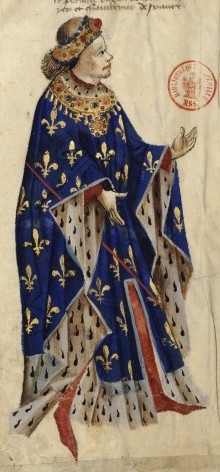
Louis I, called the Lame was a French prince du sang, Count of Clermont-en-Beauvaisis and La Marche and the first Duke of Bourbon, as well as briefly the titular King of Thessalonica from 1320 to 1321.
The counts of Nevers were the rulers of the County of Nevers, in France, The territory became a duchy in the peerage of France in 1539 under the dukes of Nevers.
Archambaud VIII of Bourbon, nicknamed the Great (1189–1242), was a ruler (sire) of Bourbonnais in the modern region of Auvergne, France. His parents were Guy II of Dampierre and Mathilde of Bourbon.

The Archdiocese of Bourges is a Latin Church archdiocese of the Catholic Church in France. The Archdiocese comprises the departements of Cher and Indre in the Region of Val de Loire. Bourges Cathedral stands in the city of Bourges in the department of Cher. Although this is still titled as an Archdiocese, it ceased as a metropolitan see in 2002 and is now a suffragan in the ecclesiastical province of Tours.
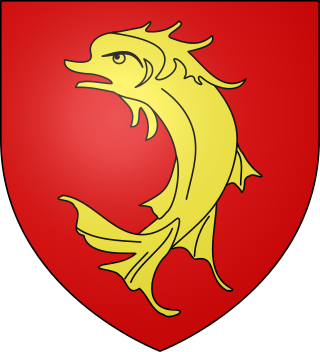
Forez is a former province of France, corresponding approximately to the central part of the modern Loire département and a part of the Haute-Loire and Puy-de-Dôme départements.
Archambaud IX of Bourbon, called "Le Jeune", was a ruler (sire) of Bourbonnais in the modern region of Auvergne, France.

Marie de Berry was suo jure Duchess of Auvergne and Countess of Montpensier in 1416–1434. She was the daughter of John, Duke of Berry, and Joanna of Armagnac. She was married three times. She acted as administrator of the Duchy of Bourbon for her third spouse John I, Duke of Bourbon, during his imprisonment in England after he was captured following the French defeat at the Battle of Agincourt in 1415, until 1434.

Anne of Auvergne also known as Anna d'Auvergne was Sovereign Dauphine of Auvergne 1400-1417 and Countess of Forez in 1372-1417 as well as Dame de Mercoeur from 1400 and 1417. She was also Duchess of Bourbon by marriage to Louis II, Duke of Bourbon.

Guy II of Dampierre was constable of Champagne, and Lord of Dampierre, Bourbon and Montluçon. He was the only son of William I of Dampierre, Lord of Dampierre, and Ermengarde of Mouchy. William I of Dampierre was the son of Guy I, Lord of Dampierre and Viscount of Troyes, and Helvide de Baudémont.
Mathilde of Bourbon was a French noblewoman who was the ruling Lady of Bourbon from 1171 until her death.
Humbert V de Beaujeu was Constable of France (1240) under King Louis IX. He was maternal grandson of Baldwin V, Count of Hainaut and nephew of Isabelle of Hainaut, queen consort of king Philip II of France. He married Marguerite de Baugé in 1219 and had six children. He participated in the Albigensian Crusade under king Louis VIII of France. In 1226, he was made royal governor of Languedoc, which had been added to royal domain. In 1232 he went to Constantinople to visit his nephew, the Latin Emperor Baldwin II of Courtenay. In 1248, he embarked on the Seventh Crusade to Egypt and laid siege to the city of Mansoura. In Mansoura, the king's younger brother, Robert I, Count of Artois, died on February 8, 1250. After leaving Egypt, he died in Syria sometime between May 21 and August 1, 1250.

Guigues IV or Guy IV was the count of Forez, Auxerre and Tonnerre from 1203 and the count of Nevers from 1226. He was still a child when his father, Guigues III, died on the Fourth Crusade and he inherited Forez. His mother was Alix and his uncle, Renaud, archbishop of Lyon, acted as regent until he came of age in 1218.
Julius of Lyon was the seventh bishop of Lyon. He succeeded Verus in the second half of the 3rd century.
Guichard, also known under the name of Guichard of Pontigny was a French churchman, Archbishop of Lyon from 1165.
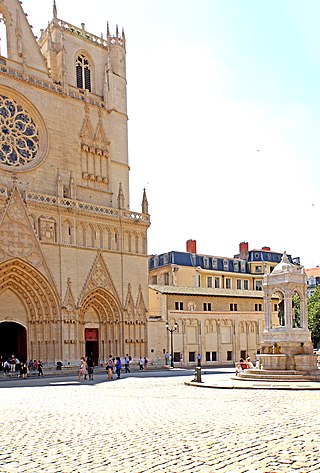
Gébuin was an archbishop of Lyon who served 1077 to 1082.

Bruno Galland is a French medievalist and archivist.
Guigues III, also numbered Guigues IV, nicknamed Branda, was the count of Forez from 1199 until his death while on the Fourth Crusade.
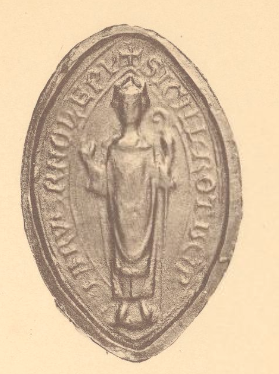
Robert of Auvergne, also called Robert de la Tour, was a French nobleman, prelate and poet from the Auvergne. He served as bishop of Clermont from 1195 until 1227 and thereafter as archbishop of Lyon until his death. He was also a troubadour, composing poetry in Occitan.

Guigues II d'Albon, known as the Fat (Pinguis), born around 1025 and died around 1079, was count in Grésivaudan and Briançonnais from 1070 to 1079, count of Albon in 1079. He came from the House of Albon.
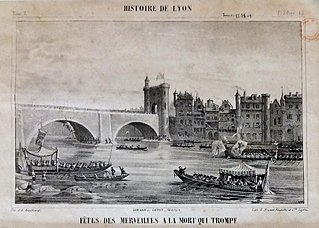
The Feast of Wonders or Feast of Miracles is both a religious and pagan ceremony that took place in Lyon on the banks of the Saône during part of the Middle Ages. It is inextricably linked with Saint Pothin's Day, a day of homage to the martyrs of Lyon in 177.












